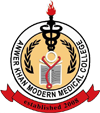Anwer Khan Modern Medical College
Library Management System

| Title: | Junqueira's basic histology: text and atlas |
| Author Name: | Anthony L. Mescher. |
| Author Sur Name: | MESCHER, Anthony L. |
| Author information: |
|
| Edition/Published: | 14th ed. _New York : McGrawHill , 2016 |
| New to this edition: |
|
|
Physical Description: xii, 560p., : illustrations (chiefly color), tables, diag., chart.; 27.5cm. |
| Notes | Includes Index. |
| Includes Index: | P. 529-560 |
| ISBN No's: | 978-1-25-925098-9 |
| Bar Code's: | |
| Shelf Location's: | 86 |
| Classification | |
| Subject: | Histology |
| Dewey Class No: | 611/.018 |
| Letter Call No: | M56j |
| LC Classification: | QL807 .H57 2016 |
| Other's Book Information | |
| Book ID No: | 1624 |
| Total Books: | 1 |
| Date of collection's: | 01-Nov-2016 |
| Donation / Purchase: | Purchase |
| Language: | English |
| Status: | Available |
| Department: | Anatomy |
| Synopsis: |
|
| Review: |
|
| Description: |
|
| Key Features: |
|
| Summary: |
|
| Abstract: |
|
| Preface: |
|
| Content: |
KEY FEATURES PREFACE ACKNOWLEDGMENTS 1 Histology & Its Methods of Study 1 Preparation of Tissues for Study-1 Light Microscopy-4 Electron Microscopy-8 Autoradiography-9 Cell & Tissue Culture-10 Enzyme Histochemistry-10 Visualizing Specific Molecules-10 Interpretation of Structures in Tissue Section-14 Summary of Key Points-15 Assess Your Knowledge-16 2 The Cytoplasm-17 Cell Differentiation-17 The Plasma Membrane-17 Cytoplasmic Organelles-27 The Cytoskeleton-42 Inclusions-47 Summary of Key Points-51 Assess Your Knowledge-52 3 The Nucleus-53 Components of the Nucleus-53 The Cell Cycle-58 Mitosis-61 Stem Cells & Tissue Renewal-65 Meiosis-65 Apoptosis-67 Summary of Key Points-69 Assess Your Knowledge-70 4 Epithelial Tissue-71 Characteristic Features of Epithelial Cells-72 Specializations of the Apical Cell Surface-77 Types of Epithelia-80 Transport Across Epithelia-88 Renewal of Epithelial Cells-88 Summary of Key Points-90 Assess Your Knowledge-93 5 Connective Tissue-96 Cells of Connective Tissue-96 Fibers-103 Ground Substance-111 Types of Connective Tissue-114 Summary of Key Points-119 Assess Your Knowledge-120 6 Adipose Tissue-122 White Adipose Tissue-122 Brown Adipose Tissue-126 Summary of Key Points-127 Assess Your Knowledge-128 7 Cartilage-129 Hyaline Cartilage-129 Elastic Cartilage-133 Fibrocartilage-134 Cartilage Formation, Growth, & Repair-134 Summary of Key Points-136 Assess Your Knowledge-136 8 Bone-138 Bone Cells-138 Bone Matrix-143 Periosteum & Endosteum-143 Types of Bone-143 Osteogenesis-148 Bone Remodeling & Repair-152 Metabolic Role of Bone-153 Joints-155 Summary of Key Points-158 Assess Your Knowledge-159 9 Nerve Tissue & the Nervous System-161 Development of Nerve Tissue-161 Neurons-163 Glial Cells & Neuronal Activity-168 Central Nervous System-175 Peripheral Nervous System-182 Neural Plasticity & Regeneration-187 Summary of Key Points-190 Assess Your Knowledge-191 10 Muscle Tissue-193 Skeletal Muscle-193 Cardiac Muscle-207 Smooth Muscle-208 Regeneration of Muscle Tissue-213 Summary of Key Points-213 Assess Your Knowledge-214 11 The Circulatory System-215 Heart-215 Tissues of the Vascular Wall-219 Vasculature-220 Lymphatic Vascular System-231 Summary of Key Points-235 Assess Your Knowledge-235 12 Blood-237 Composition of Plasma-237 Blood Cells-239 Summary of Key Points-250 Assess Your Knowledge-252 13 Hemopoiesis-254 Stem Cells, Growth Factors, & Differentiation-254 Bone Marrow-255 Maturation of Erythrocytes-258 Maturation of Granulocytes-260 Maturation of Agranulocytes-263 Origin of Platelets-263 Summary of Key Points-265 Assess Your Knowledge-265 14 The Immune System & Lymphoid Organs-267 Innate & Adaptive Immunity-267 Cytokines-269 Antigens & Antibodies-270 Antigen Presentation-271 Cells of Adaptive Immunity-273 Thymus-276 Mucosa-Associated Lymphoid Tissue-281 Lymph Nodes-282 Spleen-286 Summary of Key Points-293 Assess Your Knowledge-294 15 Digestive Tract-295 General Structure of the Digestive Tract-295 Oral Cavity-298 Esophagus-305 Stomach-307 Small Intestine-314 Large Intestine-318 Summary of Key Points-326 Assess Your Knowledge-328 16 Organs Associated with the Digestive Tract-329 Salivary Glands-329 Pancreas-332 Liver-335 Biliary Tract & Gallbladder-345 Summary of Key Points-346 Assess Your Knowledge-348 17 The Respiratory System-349 Nasal Cavities-349 Pharynx-352 Larynx-352 Trachea-354 Bronchial Tree & Lung-354 Lung Vasculature & Nerves-366 Pleural Membranes-368 Respiratory Movements-368 Summary of Key Points-369 Assess Your Knowledge-369 18 Skin-371 Epidermis-372 Dermis-378 Subcutaneous Tissue-381 Sensory Receptors-381 Hair-383 Nails-384 Skin Glands-385 Skin Repair-388 Summary of Key Points-391 Assess Your Knowledge-391 19 The Urinary System-393 Kidneys-393 Blood Circulation-394 Renal Function: Filtration, Secretion, & Reabsorption-395 Ureters, Bladder, & Urethra-406 Summary of Key Points-411 Assess Your Knowledge-412 20 Endocrine Glands-413 Pituitary Gland (Hypophysis)-413 Adrenal Glands-423 Pancreatic Islets-427 Diffuse Neuroendocrine System-429 Thyroid Gland-429 Parathyroid Glands-432 Pineal Gland-434 Summary of Key Points-437 Assess Your Knowledge-437 21 The Male Reproductive System-439 Testes-439 Intratesticular Ducts-449 Excretory Genital Ducts-450 Accessory Glands-451 Penis-456 Summary of Key Points-457 Assess Your Knowledge-459 22 The Female Reproductive System-460 Ovaries-460 Uterine Tubes-470 Major Events of Fertilization-471 Uterus-471 Embryonic Implantation, Decidua, & the Placenta-478 Cervix-482 Vagina-483 External Genitalia-483 Mammary Glands-483 Summary of Key Points-488 Assess Your Knowledge-489 23 The Eye & Ear: Special Sense Organs-490 Eyes: The Photoreceptor System-490 Ears: The Vestibuloauditory System-509 Summary of Key Points-522 Assess Your Knowledge-522 APPENDIX-525 FIGURE CREDITS-527 INDEX-529 |
Related Books
- Langman's medical embryology.
- Atlas of human anatomy
- Atlas of human anatomy
- Clinical anatomy by regions
- Gray's anatomy: the anatomical basis of clinical practice
- Junqueira's basic histology: text and atlas
- Textbook of anatomy upper limb and thorax: vol. 1
- Textbook of anatomy head, neck and brain: vol. 3
- Textbook of human osteology: with atlas of muscle attachments
- Textbook of human osteology: with atlas of muscle attachments
